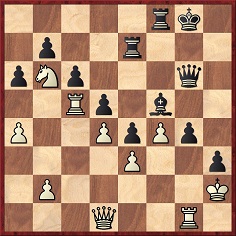
Edward Winter
An advertisement for the World Open tournament in New York (Chess Life, July 1983, page 3) mentions the word ‘prize’ over 20 times.
(538)
Wanted: drawn games which were awarded a brilliancy prize. The best-known case is probably Geller v Golombek, Budapest 1952, if only because Black has so often written about it. An earlier example was Mieses v Pillsbury, Vienna Gambit Tournament 1903. Mieses annotated the game on pages 148-150 of the May 1941 BCM, this being his final note:
‘This game was awarded a brilliancy prize with both players sharing it, since the adjudicating Committee expressed the opinion that the ingenuity of the attack, on the one side, and the skill and doggedness of the defence, on the other side, deserved the highest praise. A draw winning a brilliancy prize is quite unique in the history of tournaments.’
(1547)
From Ed Tassinari (Scarsdale, NY, USA):
‘A drawn brilliancy that immediately comes to mind is Medina v Torán, Palma de Mallorca, 1968, which is annotated on pages 171-172 of Heidenfeld’s Draw!’
We add that Heidenfeld’s book (page 138) draws attention to another case, Heidenfeld v Pachman, Madrid, 1960. The chairman of the committee appointed to award the special prizes, Roman Torán, had stated, ‘A draw has no claim to being considered at all forsuch an award’, but Heidenfeld counters with three arguments:
a) There was the Vienna 1903 precedent; b) The game chosen at Madrid for the prize ‘was later found to contain a hole as big as a house (in the winner’s play ...)’; c) Torán himself subsequently won such a prize. ‘It is not known that he refused to accept the award on the grounds that a drawn game should not be eligible.’
(1575)
Michael Furmston (Shipham, England) adds Rossolimo v Nestler, Venice, 1950 (see pages 39-40 of the November 1950 CHESS).
(1621)
C.N. 1673 gave Labatt v Dobbs, New Orleans, 1905 (see Duplication of Chess Games).
In the Alekhine article referred to in the review of The World Champions Teach Chess compiled by Yakov Estrin (C.N. 1768) the then world champion wrote, ‘Unfortunately – and this is part of the tragedy of the genuine chess artist – it takes two players to create one chess masterpiece’. It might therefore be wondered whether it is fair, in the case of decisive games, for brilliancy prizes to be awarded to the winner only. According to page 17 of Les prix de beauté aux échecs by F. Le Lionnais, there is only one recorded instance of the money being shared: a ‘beauty prize’ of 75 florins at a national tournament in Amsterdam in August 1916. The winning game was Marchand’s victory over B.J. Van Trotsenburg. The winner received 45 florins and the loser 30.
(1771)
C.N. 1771 gave the game-score, which is now readily available in databases.
At the Wijk aan Zee, 2000 tournament Kasparov showed aggressive displeasure at the attribution of game prizes, and his behaviour is worth contrasting with Carl Schlechter’s.
From page 19 of The Year-Book of Chess, 1907 here are Gunsberg’s words concerning the Ostend, 1906 tournament:
‘… Schlechter was the one competitor who accepted all things and all arrangements with equanimity amounting almost to indifference. Everything was right for him and nothing amiss, and this man, who apparently paid such little regard to his interests, was the winner of the first prize. Schlechter also showed us the generous side of his nature by declining to compete for any of the brilliancy prizes, for which he undoubtedly would have had the best chance. “I have won enough”, he said. “Let others get something too”.’
(Chess Café, 2000)
This position is from a brilliancy prize game between D. Przepiórka and I. Dominik at the Warsaw, 1919 tournament:

Black now played: 26…g3+ 27 Rxg3 Qxg3+ 28 Kxg3 Rg7+ 29 Kh2 Rg2+ 30 Kh1 Bg4 31 Qg1 Bf3 32 Rc2 Kf7 33 Rxg2 hxg2+ 34 Kh2 Rh8+ 35 Kg3 Rh1 36 Kf2 a5 37 Nc8 Ke6 38 f5+ Kf6 39 Nd6 b6 40 Nc8 c5 41 Nxb6 cxd4 42 Nxd5+ Ke5 43 f6 dxe3+ 44 Nxe3 Kxf6 45 b4 axb4 46 Nd5+ Ke6 47 Nxb4 e3+ and White resigned. (There cannot be many games in which a queen remains en prise to a rook for a dozen moves.)
The score was widely published at the time (e.g. BCM, July 1920, pages 218-219, which called it ‘a very fine and interesting game’, and the July 1921 Deutsche Schachzeitung, pages 153-154). However, on page 211 of the December 1921 American Chess Bulletin A.J. Fink of the San Francisco Chronicle observed that the BCM’s notes had given the variation 29 Kf2 Rg2+ 30 Kf1 Bg4 31 Qe1 Bf3 32 Qh4 h2 and 33…Rg1+ and that in this line White could play 33 Rc1 (‘!!!’). He added: ‘In the attacking moves of Black from here on – and there are a good many – I’ve failed to find a win. The fact must not be overlooked that the knight, stationed at b6, does good work.’
Was Fink right in believing that he had ‘cooked’ the brilliancy?
(2237)
Concerning H.N. Pillsbury’s poverty, the following by A.B. Hodges was published on pages 90-91 of the May-June 1923 American Chess Bulletin:
‘Like other great masters, Pillsbury was hampered in the development of his chess talent by the fact that it was his only source of income and at his period there was not sufficient interest manifested in this country to guarantee a livelihood to a chess master. Therefore, it was a continual struggle for him to make both ends meet. Possessing a generous disposition and holding a just pride in his association with those more blessed with worldly goods, he never placed himself under the slightest obligation, though he lamented to me that the trophies won by him in tournaments and matches were one by one parted with for their intrinsic value to meet his actual necessities.’
(2304)
Eugene Gibney (Lloydminster, Canada) draws attention to two unusual prizes that were awarded in the 1945 Canadian Championship in Saskatoon. As reported in the tournament book, there was a ‘Long Distance Prize’ (‘Twenty dollars awarded to the contestant coming the longest distance’) and a ‘Shortest Draw Prize’ (ten dollars).
What other offbeat awards have been made?
(2334)
From Ed Tassinari (Scarsdale, NY, USA):
‘1. Ree in The Human Comedy of Chess, page 173, refers to the Berlin, 1918 double-round event (Lasker, Rubinstein, Tarrasch and Schlechter), in which 1,000 cigarettes were offered as first prize. He also gives an incorrect score for Schlechter in this tournament.
2. Denker’s biographical collection of best games, originally titled If You Must Play Chess, describes the game Denker-Schwartz, N.Y. Young Masters, 1930, in which the winner was to receive a barrel of schmaltz herring in addition to the (unnamed) regular first prize (page 10).
3. Chernev and Reinfeld in The Fireside Book of Chess, page 99, state that one of the prizes for the winner of the Tarrasch v Mieses match of 1916 was a half pound of butter.
4. Reshevsky (or more likely Reinfeld) in Reshevsky’s Best Games of Chess (Dover reprint edition, page 23) states that after winning the Western Championship event, Tulsa, 1931, his “prize” money amounted to “a few cordial words”.’
Regarding Berlin, 1918, see also page 388 of Goldman’s work on Schlechter, but page 3 of Kagan’s tournament book referred to the tobacco as a Spezialpreis, i.e. an additional award. Concerning item 3 above, Tarrasch wrote on page 4 of his match book that since the butter had arrived shortly after the start of the event he and Mieses had agreed to share it straightaway, before it went rancid.
Never let it be said that we are unwilling to tackle the big issues …
(2354)
With regard to the second item in C.N. 2354, Aidan Woodger (Halifax, England) refers us to page 12 of Casey Bush’s 1991 book on Arthur Dake, Grandmaster from Oregon: ‘The pleasure of victory [in the 1930 tournament in New York] was only slightly diminished by the fact that the sponsor withdrew the prize before the last round and Arthur was not able to collect the barrel of schmaltz herring.’
(2380)
When the above three items were given on page 158 of A Chess Omnibus, we added the following in a footnote:
L. Szabó reported on page 32 of his book My Best Games of Chess that after a tournament in Kecskemét in 1945 ‘I gladly presented my second prize, ten kilogams of lard, to my amazed mother’.
From a letter contributed by Leonard B. Meyer to Chess Review, June 1949, page 161, regarding the conclusion of the New York, 1924 tournament:
‘… local chess-players were divided into Capablanca, Marshall and Réti camps, and I was in the center as a member of the brilliancy prize committee. I was strongly in favor of giving the first prize to Réti for his game against Bogoljubow. The other judges were Hermann Helms and Norbert Lederer, and it was common knowledge that originally the committeemen did not see eye to eye. However, on the night before the dinner at which the awards were to be made, the committee finally unanimously selected this game for first prize.
The next day a bomb burst. There had been a leak, and Herbert R. Limburg, president of the congress, was in a dither. He had received a letter from John Barry, objecting to the committee’s decision. The letter also included a vitriolic attack against me. It began about as follows: “It has come to my knowledge that one Meyer, who is either a knave or a moron, has decided to give the brilliancy prize to Réti”. The balance of the letter, besides discussing patriotism, included a system for deciding prizes, with points for various types of sacrifices, all of which added up to first prize for Marshall for his game with Bogoljubow.
At a hastily called meeting of the tournament committee, the decision of the brilliancy prize committee was upheld. To further sustain the verdict, I quote the following from Dr Alekhine’s annotations to the Réti-Bogoljubow game in the tournament book: “Rightfully, this game was awarded the first brilliancy prize”.
In 1930, I met Dr Tartakower in Paris. He told me that, in his opinion, when all other details of the tournament are forgotten, the Réti-Bogoljubow game will be remembered as one of the six greatest games ever played.
… It is like judging any other work of art: the experts are bound to disagree.
Just for the record, in later years, Barry apologized, and we buried the hatchet.’
(2538)
See too Chess in 1924.
C.N. 2404 drew attention to a magazine report on how R. Fischer (USA) became the only person in the world ‘to have won prizes both in a national beauty competition and a national chess tournament’.
Further particulars are available in Chess Review, June 1938, page 146 and the Australasian Chess Review, 30 June 1939, page 134. The player in question was Rosemarie Fischer of Milwaukee (born circa 1914). Her most notable chess achievement seems to have been second prize in the American Chess Federation’s women’s championship in Chicago in 1937 (American Chess Bulletin, July-August 1937, page 73).
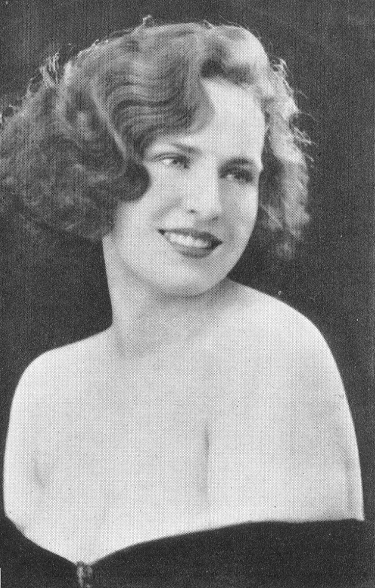
Rosemarie Fischer
(2561)
Addition on 24 June 2022:
Michael McDowell (Westcliff-on-sea, England) draws our attention to Delia Monica Duca (born 1986):
‘She has the unique achievement of having solved in the World Chess Solving Championship (in 2006 and 2011, the second time as a member of the Romanian team – she has also solved in three European Championships) and represented Romania in the Miss Universe competition in 2012. Her Wikipedia entry says that she was “national champion in solving chess problems” in 2006, but as there are a number of much stronger solvers in Romania I suspect that may mean that she was the women’s champion.’
From the bibliography (page 371) in Frank Marshall, United States Chess Champion by A. Soltis (Jefferson, 1994):
‘LeLionnais, Francois. Les Preix de Beatue aux Echecs. Payot. Paris 1970.’
A proof-reader, had there been one, would have made four or five corrections to that single line.
(2798)
Using the website http://eh.net/hmit/compare we have been looking at approximate modern-day equivalents of various notable sums (on the basis of the consumer price index calculation, and with full regard to the financial caveats mentioned at the site).
In May 1859 Morphy agreed to write a weekly chess column for one year in the New York Ledger, having been offered an advance of $3,000 (modern equivalent: $63,500).
Other examples:
First prize at New York, 1889: $1,000 ($19,000)
Purse for the 1907 world championship match between Lasker and Marshall: $1,000 ($18,700)
London Rules (1922): purse below which the world champion would not be compelled to defend his title: $10,000 ($105,000)
First prize at New York, 1924: $1,500 ($15,500)
First prize at New York, 1927: $2,000 ($20,300)
Prize-fund for the Spassky v Fischer match, 1972: $250,000 ($1,050,000).
(2806)
The figures in the above item, which was written in November 2002, have not been updated. The link to the website is now broken.
This position arose in the brilliancy prize game between A. Alekhine and K. Sterk, Budapest, 9 September 1921:
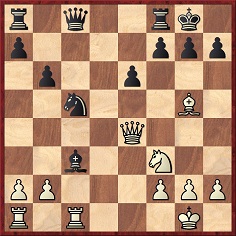
In his first volume of Best Games Alekhine now gave 20 Qe2 an exclamation mark and wrote:
‘More energetic than 20 Qb1, suggested by some annotators, which would have yielded the win of only two minor pieces for a rook, after 20…Bb4 21 a3 Qb7, while allowing Black numerous defensive possibilities.’
In the French version, however, Alekhine referred to winning a pawn as well as a rook (‘… n’aurait donné que le gain de deux pièces mineures pour tour et pion …’ – page 135 of volume 1 of Deux cents parties d’échecs).
But was 20 Qe2 a good move? Such recent books as Alexander Alekhine’s Best Games (Batsford, 1996) and the first volume of Alexander Alekhine (Chess Stars, 2002) have mentioned that (after 20…Bb4 21 a3 Qb7) White can play 22 b3, which ‘actually nets a whole piece’ (Nunn).
We would point out that 22 b3 (given two exclamation marks by the Chess Stars book) is not a recent discovery. It was pointed out by Zoltán Vécsey on page 169 of the December 1921 Časopis Československých Šachistů.
As regards the conclusion of the game, all contemporary magazines that we have consulted give 27 Rf1 Rac8 28 Rd4 Qf5 29 Qf4 Qc2 30 Qh6 Resigns. Alekhine’s book contracted this to 27 Rf1 Qf5 28 Qf4 Qc2 29 Qh6 Resigns, as was mentioned by Colin Malcolm on page 177 of CHESS, June 1953.
(2830)
See also C.N. 6934.
From a 1913 correspondence game between Tuffli and Rimathé:
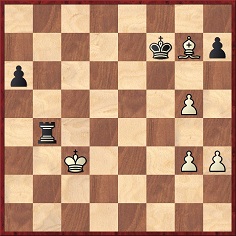
The game continued 1…Rg4 2 Be5 Rxg5 and Black won.
Source: pages 10 and 108 of Schachtaktische Bilder by E. Voellmy (Basle and Leipzig, 1935).
(2850)
We can inch forward/back by quoting from page 15 of the January 1913 Schweizerische Schachzeitung. The Tuffli-Rimathé correspondence game (played in a tournament which ran from 6 July 1910 to 13 August 1912) was stated to have won the second brilliancy prize, although the Swiss magazine merely picked it up in the following position:
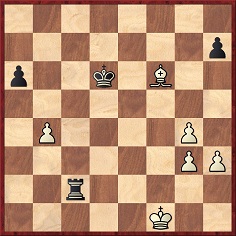
46 g5 Rc4 47 Bg7 Ke7 48 Ke2 Kf7 49 Kd3 Rxb4 50 Kc3 Rg4 51 Be5 Rxg5 and Black won.
(2866)
From page 39 of Chess the Hard Way! by D.A. Yanofsky (London, 1953) comes this passage regarding the 1939 Olympiad in Buenos Aires:
‘By winning the next two games I scored 9½ points out of a possible 10 and was awarded a silver cigarette holder inscribed: “Mejor Jugador del Torneo” [best player of the tournament].’
Times have certainly changed, as it is hard to imagine that organizers today would offer a 14-year-old boy anything smacking of smoking.
(3003)
Hans Maurer (Effretikon, Switzerland) writes regarding a report on page 178 of the 17 May 1914 issue of Deutsches Wochenschach. It refers to a banquet held in honour of the participants in the St Petersburg tournament during which the young Prokofiev gave a piano recital and each of the 11 participants in the tournament received a wine goblet (old Russian style) donated by Carl Fabergé.
Our correspondent wonders if anything is known about the fate of these objects.
For reference, below is the relevant passage from Deutsches Wochenschach:
‘Eine glänzende Klavierleistung des jungen Laureaten des St Petersburger Konservatoriums, Herrn Prokofjew, bildete den Schluss des überaus gelungenen Abends. Der Hofjuwelier K.E. [sic] Fabergé hat 11 kunstvoll gearbeitete Weinbecher (in altrussischem Stil) für sämtliche Teilnehmer am Grossmeisterturnier gespendet.’
(3105)
Some additional information appears on page 90 of the February-May 1914 Wiener Schachzeitung: the goblets, presented by Eugene Fabergé, were gold enamelled, and the five finest were reserved for the participants in the Final Section (i.e. Capablanca, Lasker, Tarrasch, Alekhine and Marshall). As in the case of C.N. 3105, we give for the record the original German text:
‘Eine schöne Überraschung bereitete den Turnierteilnehmern der Hofjuwelier Eugen Fabergé, indem er am 25. April (8. Mai) auf dem zu Ehren der Meister vom Schachverein gegebenen Festbankett für jeden Turnierteilnehmer einen goldenen emaillirten Becher in altrussischem Stile spendete. Sechs Becher wurden sofort den Nichtpreisträgern überreicht, die fünf schönsten Becher hingegen für die fünf Sieger aufbewahrt, die von 10. Mai bis 22. Mai n. St. um die Preise zu ringen hatten.’
(3123)
It has been noticeable in recent years that the intensity of hankering for an/any award is often inversely proportional to the merit of the hankerer and to the prestige, if any, of the award hankered for. The spectacle is an embarrassment, of course, but it is difficult too to take seriously those ‘hall of fame’ schemes so favoured in the United States. There even exists, we jest not, a ‘World Chess Hall of Fame’ whose ‘inductees’ as ‘charter members’ include ‘Robert James (Bobbie) [sic] Fischer’. He is in the 2001 crop, which also cheapens the memory of Morphy, Steinitz, Lasker and Capablanca (although Alekhine escapes) by appointing them World Chess Hall of Fame inductee charter members, or possibly World Chess Hall of Fame charter member inductees.
Turning to an older initiative on a rather more elevated plane, we wonder what became of the FIDE project reported on page 648 of the December 1980 BCM:
‘The International Chess Federation has decided to award gold medals as follows: “Alekhine Medal” for the best attack; “Capablanca Medal” for the best endgame; “Lasker Medal” for the best defence, and “Steinitz Medal” for the best strategical plan. A commission, composed of Dr M. Euwe (Chairman), GM G. Barzca, GM A. Kotov, GM A. Matanović, GM M. Najdorf and GM L. Schmid, will select the players that will be awarded the prizes annually at the FIDE Congresses. For the first award, in 1981, games played in 1980 must be sent to the FIDE Secretariat by 1 March 1981, with short commentaries ...’
(3882)
The extract below from pages 112-113 of Lord Dunsany’s autobiography While the Sirens Slept (London, circa 1945) was given in C.N. 4141:
‘Early that same spring [1929] Capablanca, perhaps the greatest chessplayer the world has ever known, and at that time Champion of the World [sic], came to London and gave a display at Selfridge’s. He played simultaneous chess against three representatives from each of the seven counties that are nearest to London, which means roughly the seven strongest counties in England, and Mr Selfridge offered a prize to whatever county did best against him. I was asked to be one of the players from Kent. We sat at a row of tables in a long room with a large crowd leaning over us, and Señor Capablanca walked along the row. I was rather anxious that it should not be thought that I had been chosen to play merely because I was president of the Kent Chess Association, and the only way of showing that was to hold out for at least half an hour. I have mentioned earlier my ignorance of the openings, and Capablanca, who of course had first move on every board, chose the opening that probably corresponds with whatever is the most complicated theory in any science, that is to say the Ruy López. I made for my fourth move one that should have come later, not realizing how much it mattered. Of this simple blunder Capablanca naturally took immediate advantage, and I looked very unlikely to hold out for half an hour. But then I began to play, and by sacrificing a pawn got out of the muddle into which I had strayed, though playing with a pawn down against Capablanca did not seem a very hopeful proposition. Curiously enough my blunder saved me, for in the complications of an ordinary Ruy López as played by Capablanca I should no doubt have been easily beaten; but the clock went on and I was still playing, and at last I got the pawn back, and at the end of four hours when play ended, I had an obvious draw, and Capablanca conceded rather reluctantly a draw to my neighbour on my left, so that Kent had scored one point against him, a draw being half; and a player from Hertfordshire had won his game, and, these two counties being equal, the man who had won and we two who had drawn were all given a prize by Selfridges. For Capablanca had beaten all the rest [sic – two other players drew]. As the prize was handed to me the representative of the firm who gave it said, “And if there is anything you would prefer, do let us know”. The prize was wrapped up in a box, and I said I was sure that there would not be anything that I should prefer to it. But when I got home and opened the box, I found that the prize was a cocktail-shaker; a very handsome one, but still to a chessplayer as useless as reindeer-harness to anyone in a Southern country. So in spite of what I had said, I wrote asking if, with the exception that I have mentioned, I could be given anything else, and I was kindly given, duly inscribed, the largest and most useful thermos flask that I have ever had, and after nearly 15 years it is as good as ever. My game with Capablanca was recorded in The Times, in the Chess Column, that year.’
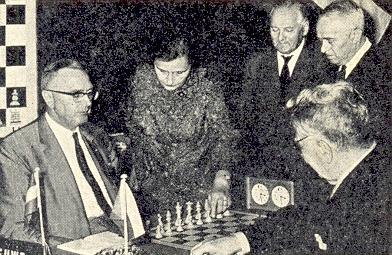
Before proceeding, readers are invited to identify the five people in the above photograph.
It was taken during a small tournament in Bladel, the Netherlands in 1969, and the opening 1 d4 f5 2 c4 g6 3 Nc3 Nh6, played in one of the games, was christened the Bladel Variation. The average age of the participants was nearly 70, and the photograph shows all four of them: M. Euwe is facing K.Opočenský, and in the top right-hand corner are H. Müller and S. Flohr. The Dutch Defence game was a 12-move draw between Flohr and Euwe. Standing next to the Dutchman is the widow of Richard Réti; the tournament commemorated the 40th anniversary of his death.
The photograph comes from page 14 of CHESS, September 1969, which reported:
‘As an additional gesture, Réti’s widow has also been invited over from Moscow. She attended every round and watched all the games with great interest.’
Biographical information about her will be appreciated. On page 194 of the July 1926 Wiener Schachzeitung Hans Kmoch remarked that from the Moscow, 1925 tournament Réti brought back not only a ‘beauty prize’ for his game against Romanovsky but also a beautiful young Russian as his wife:
‘... Réti, der aus Moskau nicht nur den Schönheitspreis für seine Partie gegen Romanowski, sondern auch eine schöne junge Russin als Gattin mitgebracht hat, mit der er nun seine Hochzeitsreise unternimmt.’
On page 3 of Réti’s Best Games of Chess (London, 1954) Harry Golombek referred to Kmoch’s comment, and page 129 mentioned again the prize won by Réti for his game against Romanovsky. However, Golombek went astray on page 37 of Chess Treasury of the Air by T. Tiller (Harmondsworth, 1966) by stating that Réti did not win such a prize in the Moscow, 1925 tournament. Referring to the opening ceremony of the Botvinnik v Tal world championship match in 1960 Golombek wrote:
‘One of the items this time was a prelude for pianoforte dedicated to Tal and Botvinnik. Afterwards I was introduced to the composer who, surprisingly enough, wasn’t a chessplayer. His connexion with the chess world was that his wife was the former Mrs Réti. Despite the passage of some 35 years since the remark was made, on looking at her I realized what was meant when it was said that Réti may not have won a beauty prize over the board at Moscow, 1925, but he had come away with one all the same. For this was the beautiful Russian girl whom he had met and married in Moscow that year.’
Can the name of Mrs Réti’s later husband be established (possibly from a souvenir programme for the opening ceremony of the 1960 match)?
(4912)
Michael Lorenz (Vienna) draws attention to the reference to Réti’s marriage on page 189 of Richard Réti šachový myslitel by Jan Kalendovský (Prague, 1989). Her maiden name was Rogneda Sergeievna Gorodetskaia, and she was the daughter of the Russian poet Sergei Gorodetsky (1884-1967). The couple met during the Moscow, 1925 tournament and married in Moscow on 28 May the following year (Réti’s 37th birthday). A footnote in the Czech book stated that in 1987 she was still alive, in Moscow.
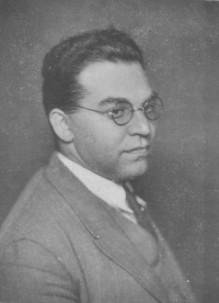
Richard Réti
(4929)
There are two photographs of Réti’s wife on pages 29-33 of the Russian-language work Richard Réti by Anatoly Matsukevich (Moscow, 2005). See too C.N. 5041.
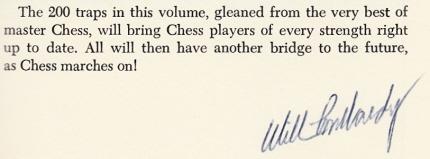
Above, at the end of his Preface, is William Lombardy’s signature in our copy of Modern Chess Opening Traps (C.N. 8718), which was later published in the United Kingdom by B.T. Batsford Ltd. under the title Snatched Opportunities on the Chessboard.
In most of the 200 games the players’ names are omitted, but an exception, on pages 304-308, is Lombardy’s ‘mini-delayed brilliancy’ against Benko, introduced as follows:
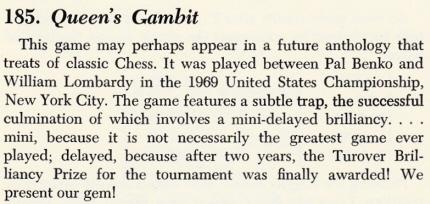
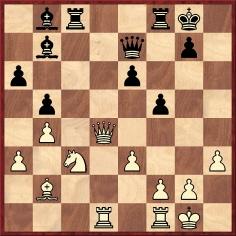
Position before 22...Bf3
Even this notable game is mishandled by some databases (‘USA, 1970’). It was played on 14 December 1969, in the ninth round of the US Championship in New York, as shown in a table on page 9 of Morton Siegel’s tournament book.
From pages 52-53 of that work:
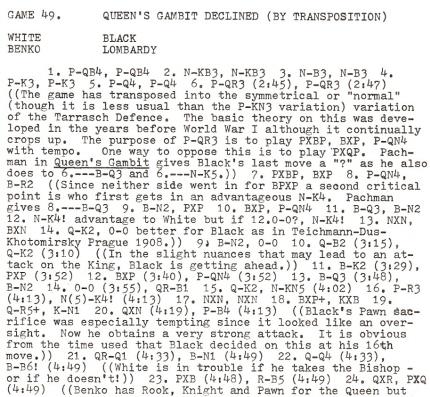
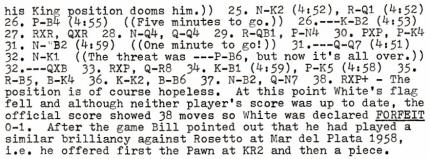
Regarding clock times, page 6 gave this explanation:
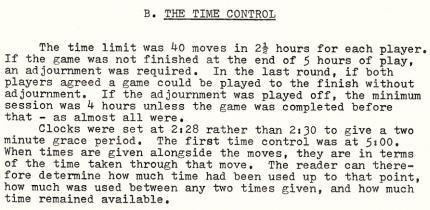
Lombardy annotated the game on pages 211-213 of Understanding Chess. My System, My Games, My Life (New York, 2011).
(8719)
‘Would’ can be strange, and C.N. 8632 (see Chess and the English Language) mentioned its unnecessary inclusion in historical narratives (‘Alekhine died in 1946, and two years later Botvinnik would become world champion’, instead of simply ‘became world champion’). Another quirk, favoured by presenters of history programmes on television, is recourse to ‘would have’ to disguise speculation or mind-reading: ‘It is in this room that he would have decided to ...’ Then there is all the prolixity in quizzes. ‘Would you be ready?’ is answered not by ‘Yes’ but by ‘I would indeed’, and later we may hear, ‘I wouldn’t have a clue’ or the frightful excuse for ignorance of something uncontemporary: ‘that would be before my time’. Asked in a chess quiz to identify the player who was nicknamed ‘the Black Death’, a contestant could well use four words instead of one: ‘that would be Blackburne’. A more challenging question is: which chess writer used the pseudonym ‘Eze’? That would be Telling.
As shown in C.N. 8677, on page 44 of Brilliance in Chess (London, 1977) Gerald Abrahams stated that a Tartakower v Colle game was ‘played at Eze in 1930’, whereas ‘Eze’ was merely the pseudonym of Oscar Leonidas Telling, who brought out a book on the Nice, 1930 tournament.
The Eze/Nice confusion, which has yet to be explained, recurred on page 84 of Abrahams’ book, where he explicitly wrote:
‘In a tournament at Eze, in the South of France, in 1930, the best player was Tartakower ...’
He then gave two further positions from the event, Colle v O’Hanlon and O’Hanlon v Znosko-Borovsky. The diagrams were respectively labelled ‘Eze 1930’ and ‘Played Eze’. Abrahams wrote that the two games received brilliancy prizes, from a newspaper which, as he had already done on page 44, he called L’Eclairceur de Nice. L’Eclaireur de Nice is/would be correct.
After a few general comments about brilliancy (‘Let us not call every sacrifice brilliant’) Abrahams gave a footnote:
‘There must be something in the air of the South of France because in 1974, at Nice, they awarded the first brilliancy to an English Master (certainly a fine player) who made a sacrifice on K6 for which the board was screaming – and they rejected harder pieces of play.’
Even today, when technology increasingly encourages people, including the uninformed and illiterate, to share their opinions about tout ce qui bouge, it may still seem rather inelegant to dispute brilliancy-prize decisions. The case referred to in Abrahams’ footnote was Michael Stean’s victory over Walter Browne, a game which Harry Golombek published on page 235 of A History of Chess (London, 1976):
‘One of the prettiest games of the [Nice] Olympiad was the following, for which the winner was awarded the Turover Brilliancy prize of $1,000.’
Golombek was one of the three judges, the others being Reuben Fine and Lothar Schmid, as reported on page 667 of the October 1974 Chess Life & Review.
The magazine published the game with Stean’s annotations and also stated:
‘Our own chess philanthropist, I.S. Turover, who has been giving out 100 dollar bills as brilliancy prizes for many years, has decided that a brilliant game’s cash value is high indeed. “I.S.” believes in chess beauty and is willing to pay, in addition to many smaller cash prizes during the year, $1,000 to the “most brilliant game played in the premier tournament of the year”.
This year it was decided to select the winning game from those played in the Final A group at the Nice Olympics. In addition to the money, the winner receives a small trophy which is a replica of a larger trophy to be kept in the United States and on which will be engraved the name of the winner each year.’
The heading of the article was ‘I.S. Turover $1,000 World Brilliancy Prize’, and although many copycat webpages describe the prize as ‘annual’ and Stean as ‘the first winner’, we are not aware that it was ever awarded again.
On pages 281 and 282 of the May 1975 Chess Life & Review L. Kavalek reported that Turover had given a prize for the most brilliant game won at the Wijk aan Zee tournament at the beginning of the year (again Walter Browne was the loser, the victor being Vlastimil Hort), but no ‘World Brilliancy Prize’ seems to have been awarded to any game after Stean v Browne. Would that it had. Turover died in 1978, aged 86.
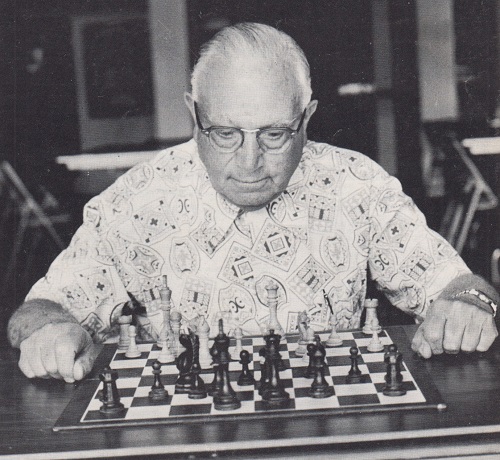
Isador Samuel Turover, front cover, Chess Life, November 1968
A brilliancy prize oddity was related on page 6 of Chess Games and Chess Problems by W.B. Suesman (Providence, 1980):
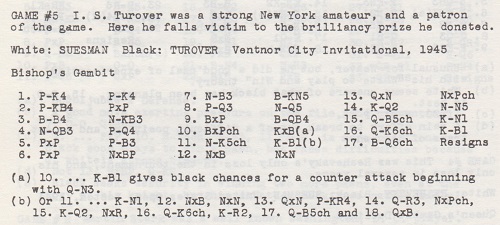
The Suesman v Turover game was given in C.N. 2177 (see pages 241-242 of Kings, Commoners and Knaves), but we now note that it was played in 1944, and not 1945. I.A. Horowitz annotated it on pages 4-5 of the August-September 1944 Chess Review, and the brilliancy prize was discussed on page 15 of the Brooklyn Daily Eagle, 31 August 1944.
C.N. 2177 also mentioned another player who lost a game which received a brilliancy prize donated by himself, and it is an appropriate name with which to end this little stroll: Wood.
(9051)
We first mentioned the B.H. Wood matter in C.N. 1548:
An oddity regarding brilliancy prizes is the case briefly mentioned on page 281 of the March 1984 CHESS. At a minor tournament B.H. Wood put up a brilliancy prize; the winner was C. Sims, for his defeat of B.H. Wood.
Concerning the brilliancy prizes at Wijk aan Zee, 1975, further information is on pages 11, 169 and 177-178 of Lubosh Kavalek’s book Wijk aan Zee Grandmaster Chess Tournament 1975 (New York, 1976). Hort won the Turover prize for defeating Browne, and Kavalek received the Leo van Kuijk prize for his draw with Portisch. Kavalek’s discussion of the latter game is exceptionally detailed (pages 177-192), and his concluding remark reads:
‘To play games like this one may give us some pleasure, if we suffer our way through it. It may give pleasure to thousands of chess fans when they play it over, and it revives the feeling that the romantic chess art of the last century has not been lost.’
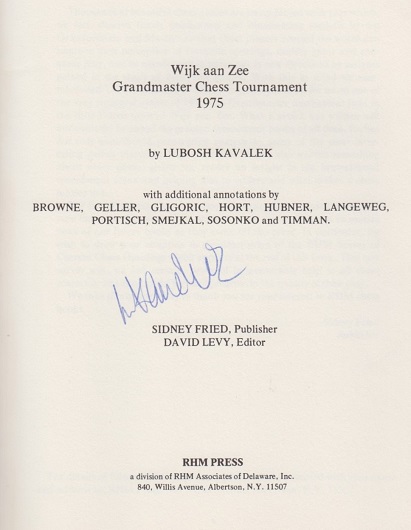
Some other instances of brilliancy prizes awarded to drawn games were referred to in C.N.s 1547 and 1575; see pages 190-191 of Kings, Commoners and Knaves.
On page 232 of the August 1970 BCM Wolfgang Heidenfeld wrote:
‘... a phrase like “Alekhine’s Best Games” is really ambiguous: it may mean two entirely different things, viz. (a) the games Alekhine played best and (b) the objectively best games in which Alekhine was a participant (in which the standard of the game is achieved by both partners) – thus he need not necessarily have won them. This, in fact, is the basis of my anthology Grosse Remispartien.
In fact, it is little short of ludicrous that Alekhine’s Best Games does not contain his draw against Marshall at New York, 1924, where a most original and new strategic conception by Marshall is met by an amazing tactical finesse of Alekhine’s, the whole (drawn) game being one of the greatest ever played. It is similarly ludicrous that Golombek’s anthology of Réti’s Best Games is without his draw against Alekhine at Vienna, 1922 – which has been christened the Immortal Draw and which even Alekhine does not pass over in his own collection. Similarly some game collections of Tal’s are deprived of the fantastic draw against Aronin at the 24th Soviet championship (Moscow, 1957) – a game of which Keres stated in a much-acclaimed article that one could not do justice to Tal’s achievement in that tournament without coming to grips with it.’
(7049)
See too The Best Games of Chess.
On the subject of announced mates:
‘A novel prize is offered by a member of the Manhattan Chess Club to the competitors in the club championship tourney. The prize is to be awarded “for the best long-distance mate or, in other words, to that player who shall announce mate the furthest number of moves ahead”.’
Source: Lasker’s Chess Magazine, December 1904, page 59.
(10301)
A draw between F.K. Kelling and E.A. Hicks which, as reported on page 13 of the Evening Star, 10 March 1923, won White the ‘best recovery’ prize in the New Zealand Championship, Christchurch, 26 December 1922:
1 e4 e6 2 d4 d5 3 Nc3 dxe4 4 Nxe4 Nd7 5 Nf3 Ngf6 6 Bd3 Nxe4 7 Bxe4 Nf6 8 Bd3 b6 9 Bb5+ Bd7 10 Bxd7+ Qxd7 11 Ne5 Qd5 12 O-O c5 13 c4 Qb7 14 Qa4+ Nd7 15 Rd1 Rd8 16 Nc6 Rc8 17 d5 a6 18 Qb3 Nf6 19 Qe3 Bd6 20 f4 O-O 21 Qd3 exd5 22 cxd5 Rfe8 23 b3 Bf8 24 Bb2 Nxd5 25 Na5 bxa5 26 Qxd5 Qb4 27 Be5 Red8 28 Qxd8 Rxd8 29 Rxd8 f6 30 Bb2 c4 31 Bd4 cxb3 32 axb3 Kf7 33 Rc1 Kg6 34 g4 Bd6 35 f5+ Kg5
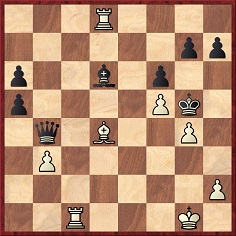
36 Be3+ Kh4 37 Kf2 Bf4 38 Rd3 Qe4 39 Ke2 Bxe3 40 Rxe3 Qg2+ 41 Kd3 a4 42 Rc4 Qb2 43 Ke4 Kxg4 44 Kd5+ Kxf5 45 Rf3+ Kg6 46 Rg3+ Drawn.
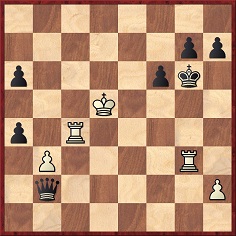
(11709)
See too Chess Awards.
To the Chess Notes main page.
To the Archives for other feature articles.
Copyright: Edward Winter. All rights reserved.